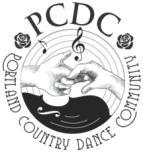By Kelly Tabor, Contra Committee Chair
I am your Contra Committee Chair, and I have a confession: The first PCDC board meeting I ever attended was this past summer. I was driving down I-84 with a board member attending via Zoom in my passenger seat. PCDC’s fiscal year had just ended and our treasurer was going over numbers. ECD made a profit of $700 or so. Contra lost $1800. This was no surprise to anyone. We had taken a loss at every single dance from April to New Year’s Eve, and at most dances since then.
We’d hoped we could outrun the money problem by boosting attendance. We didn’t necessarily need people to pay more to dance, just more people to attend. That didn’t work, ultimately. The very well-attended Thanksgiving contra dance, for example, made a profit of only $30, with an average admission of $11 per person. But this small profit evaporates when you look at our other looming concern: we haven’t given our talent a raise this century.
We pushed off that concern long enough that we need to address it right now. All the surrounding cities pay about 30% more. The board has approved increasing the minimum talent pay and will continue to discuss other aspects such as sound engineer pay (that could fill an entire article) and travel reimbursement (gas costs more than $1.15 per gallon now–who knew?). Starting January 1, PCDC will pay callers and musicians an extra $20 each, bringing the total pay to $90 for ~5 hours of specialized work on the night of the dance (and many more hours in rehearsal). For perspective, we would need to pay our talent $150 to keep pace with the inflation since the 1990s.
And that well-attended Thanksgiving dance? With the raises for talent, that would be a loss of $70. And once we settle sound and travel pay, that loss will be much higher. With the January talent raises, the dance would break even only with an average admission of $12.31 per person. The thing is, we need our better-attended dances to do more than break even: they need to make up for the lesser-attended dances. Our least-attended 2023 dance had 42 dancers; each dancer would have had to pay $22 each for the dance to break even.
How are other organizations managing all of this?
They charge more: $12 is a common minimum.
They dance less: They dance every other week with summers off, compared to Portland’s 6 or 7 dances per month.
They have cheaper halls: Many are in lower-cost cities or have smaller halls or sweetheart deals. At $330 per night, Fulton is the cheapest hall we can fit into at pre-pandemic attendance numbers. If we give up this hall now while attendance is lower, we won’t get it back.
How are our sliding scale admissions working?
PCDC instituted sliding scale admissions a few years before the pandemic. Admission went from $11 for members and $12 for nonmembers to a $6–15 sliding scale. It worked pretty well. People kept paying what they’d been paying or threw in more if they could. People who wouldn’t otherwise attend could now pay less. Post-pandemic, the scale is $6-20. The committee very specifically didn’t want to increase the minimum, so we changed the suggested ceiling. We fully expected losses regardless in the post-pandemic world, but at the time, we expected it to be a temporary state of affairs.
But inflation has been rough. Wages are stagnant (just ask our talent!). These are not temporary obstacles. We don’t want to raise the minimum price or get rid of our sliding scale. But our dances cost a bare minimum of $815 to put on for a 3-person local band with no travel expenses. A local 4-person band is $905. An out-of-town band costs us more. With 50 dancers paying admission, that’s an average of $18.10 each to bring in a small local band—and more for a larger or out-of-town band. Once we implement sound and travel increases, this cost will be higher.
Money taken in at the door covers only that one dance—extra proceeds are split with the talent. Our pay structure affects our available talent selection and their willingness to play for us. To offer some perspective as a newer caller: I made more, even after gas, calling half a summer evening in Seattle than I do calling a full evening in Portland.
You may have noticed a new admissions sign at our dances.
Our new admissions sign lists a suggested price of $15. Below this, our sliding scale is still there, still with the $6 minimum. This is our final attempt to break even before we have to increase the minimum. Please pay $15 if you can. If you can comfortably pay more than that, by all means, please do so. Your presence is the most important thing, so if $6 is what keeps you able to dance, $6 is perfect.
